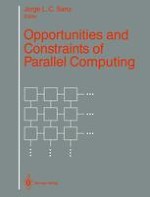At the initiative of the IBM Almaden Research Center and the National Science Foundation, a workshop on "Opportunities and Constraints of Parallel Computing" was held in San Jose, California, on December 5-6, 1988. The Steering Committee of the workshop consisted of Prof. R. Karp (University of California at Berkeley), Prof. L. Snyder (University of Washington at Seattle), and Dr. J. L. C. Sanz (IBM Almaden Research Center). This workshop was intended to provide a vehicle for interaction for people in the technical community actively engaged in research on parallel computing. One major focus of the workshop was massive parallelism, covering theory and models of computing, algorithm design and analysis, routing architectures and interconnection networks, languages, and application requirements. More conventional issues involving the design and use of parallel computers with a few dozen processors were not addressed at the meeting. A driving force behind the realization of this workshop was the need for interaction between theoreticians and practitioners of parallel computation. Therefore, a group of selected participants from the theory community was invited to attend, together with well-known colleagues actively involved in parallelism from national laboratories, government agencies, and industry.
